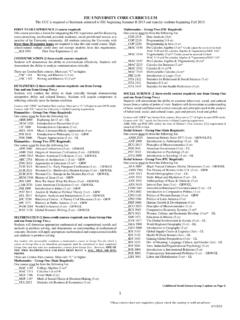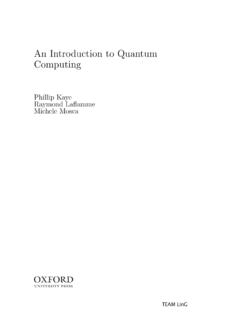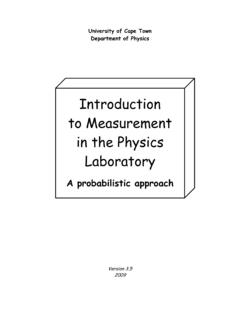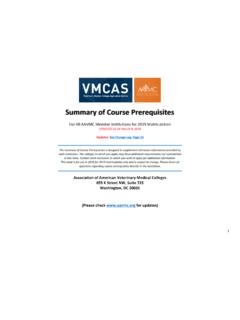Transcription of Guide to Uncertainty Propagation and Error Analysis
1 Guide to Uncertainty Propagation and ErrorAnalysisStony Brook Introductory Physics Organization of This Guide ..21 Random vs. Systemic Error .. Quantifying Error : Absolute vs. Relative Error .. Comparing Quantities with Uncertainties ..52 Random Basic Uncertainties .. Uncertainty Propagation Formulas .. Where do those formulas come from? .. Uncertainty Propagation Examples .. Example .. Example .. Example .. 153 Systemic Isolating Systemic Errors .. Determining the Effects of Systemic Errors .. 164 Other Things that are NOT errors .. Significant Figures .. Number Sense for Uncertainties .. 19A Mathematical What is an Uncertainty really? .. WhyN 1? .. A Fuller Explanation of Error Propagation Formulas .. 1 Variable Error Formulas .. 2+ Variable Error Formulas .. Statistical Independence.
2 Higher Order Effects .. 251B White Lies In These Different Uncertainty Quantifications .. Degrees of Confidence .. Correlated Errors: Covariance Matrices .. 29C Data Fitting: Procedures and Fitting a Line Without Error Bars .. Solving the Linear Fit .. Linear Fits Without Error Bars In Context .. Fitting General Linear Models .. Linearizing Nonlinear Models .. Fitting With Vertical Uncertainties .. Horizontal Error Bars .. Nonlinear Fitting of Models .. PHY133/134 Plotting Tool .. Organization of This GuideThis Guide is split into two parts: the main text (with numbered sec-tions) and the appendices (with lettered sections). For the introductory labs(PHY121/122 and PHY133/134), you should know the material from the and are both optional, but recommended. Section pro-vides some motivation that may help the formulas to stick in your mind, butyou can do the calculations without this motivation.
3 Section works througha few nice examples in very explicit detail, but some of you may not require thislevel of appendices are purely supplementary material. You may appreciatethem in later lab classes, or to further your understanding. They also may bereferenced in the lab manuals on an as-needed final note, for your convenience: this PDF is hyperlinked. Click on asection header in the table of contents to go to that section. Similarly, clickingon a section or equation number in the text will take you to that section IntroductionError is one of the most important features of doing quantitative you were doing a lab to check whetherF=ma. Your measuredvalue ofFis , and your measured value ofmais this good? Bad? Who knows? I mean, it s close, so perhaps you cansay it agrees. If, on the other hand, you did a super-precise measurement, thenmaybe you can actually say thatF=mais or not you confirm or deny Newton s second law depends on theprecision of your experiment!
4 So, in order to do our quantiative Analysis properlyand come to a conclusion as to whether it is correct or not, we need to knowour Random vs. Systemic ErrorThere are two kinds of Error that one deals with in the lab:random errorandsystemic Error , per the name, are statistical effects that push your data everywhich way from the true result, with no consistency to its effects. These willresult in your data being right on average, but any individual data point will beoff. This results inuncertainty. Random Error won t make you wrong (usually),but will limit how much you can say. Data that doesn t have much randomerror is errors are effects that come from aspects of your system that youhave not considered. These result inbias, as well as more complicated is to say, systemic Error will push your data in someconsistent, reliableway. It won t (necessarily) increase the scatter of your data, so it won t makeyour data look all over the place.
5 Rather, it takes the nice straight line yourdata should make, and turns it into a line of a different slope (or another curvealtogether). Quantifying Error : Absolute vs. Relative ErrorThere are two general ways to talk about Error : absolute Error and you have a quantityXthat you are measuring, theabsolute errorinX,denoted as Xor (X), is simply the amount by which you are (or could be) instance, if you measure something to be , then you might reasonablysay that your Uncertainty is 1cm - that is to say, you could have been off by could also report this same Uncertainty as arelative Error , denotedas rel(X). This is when you compare the size of your Error to the size of theoriginal formula for relative Error is: relX= X|X|(1)Thus, in the above example, your 1cm Uncertainty on your measure-ment would turn into a relative Error of In other words, the absoluteuncertainty on your measurement is times your original may be more familiar with the idea of relative Error from the closelyrelatedpercent Error , which is just 100 times relative and absolute errors have advantages and disadvantages asmethods of quantifying your Error is straightforward and easier to understand.
6 They are alsonecessary for direct comparison: if I ask you whether 5cm 1mm agrees witha theoretical value of , that s easy to tell; if I ask whether 5cm with arelative Uncertainty of agrees with the same theoretical value, that s notnearly as such, when you state a quantity in your lab report, it should typically bewrittenX X- that is to say, you talk about uncertainties with the absoluteerror when reporting them. (This will also be the kind of Error that these man-uals will be referring to if they don t explicitly say relative Error . )Relative errors give a sense of how big an Error is in a general sense. Thatis to say, if I tell you I have a 5% Error , you have an immediate sense of howmuch I m off by; if I tell you I have a 1cm Error , whether that s big or smalldepends on what I m particular, relative errors can be compared across different sources of er-rors: if one quantity has a relative Uncertainty of and another of , it seasy to see that the contribution of the second to your final amount of erroris negligible.
7 If I tell you one has an Error of 1cm and the other an Error , you have no sense of which is the more relevant contribution. Therefore,relative errors are the better things to look at if you want to compare errors ofdifferent your original quantity is zero (or, more generally, you are trying to measure somethingwhich should be equal to zero), then you shouldn t use relative Error . As a more concise ruleof thumb: if your relative Error is larger than 1, you should just use absolute , a note on units: absolute errors will have the same units as the orig-inal quantity,2so a time measured in seconds will have an Uncertainty measuredin seconds, etc.; therefore, they will only be unitless if the original quantity isunitless. Relative errors Comparing Quantities with UncertaintiesOnce you have an Uncertainty , you can use it to compare quantities. In thisclass, we will use two methods to do first method is used if only one quantity has Uncertainty .
8 This is typicalif one is comparing a calculated quantity from lab to a theoretical value. 4 Inthis case, one simply sees whether the quantity without Uncertainty (the the-oretical value ) lies within the Uncertainty range of the experimental is to say: if one is comparingA AtoB, one simply sees whether ornot it is the case thatA A< B < A+ second method is used if one has two quantities with Uncertainty . Thisis usually for comparing different measurements to each other. In this case, onesees whether the Uncertainty ranges overlap at these ranges overlap, thenwe say the two values are consistent - bothcouldbe correct to within uncer-tainty concisely: to compareA AtoB B, we see whether we have boththatA+ A> B Band thatA A< B+ Random Basic UncertaintiesIn order to get a sense of what our Uncertainty will be in our final result, wefirst should know what Uncertainty comes from our measurements we do this depends on the nature of our first thing we have to do is to determine what the dominant source ofour Uncertainty is.
9 Is it the limits of our measuring apparatus? Is it the physicalarrangement of our device?2 Actually, you could change the modifier if you wanted to - for instance, 1mm -but there s rarely a reason to do is a part of what makes them directly theoretical values typically also have Uncertainty , but such uncertainties are smallenough compared to the uncertainties in our experiments as to be the sake of introductory labs, this is how we will do comparisons. In general, a slightlybetter method is to see if the difference (with uncertainties propagated) is consistent with zero(in the sense of a theoretical value). This accounts more accurately for uncorrelated instance: if you re measuring the size of a string, the limit could gener-ally be taken to be the markings on the ruler. However, if you were measuringthe distance between two houses down the street, there would likely be signif-icant Uncertainty from the size of the houses themselves, because they aren t point houses.
10 Your precision won t be 1mm there, even if you measure with a super-preciseruler, because the ruler isn t the limit of your Uncertainty . Even if you specifiedan exact position (like center of mass of the house ), you re unlikely to be ableto know what that position is to within , we need to figure out how to determine this Uncertainty . There are avariety of simple ways to do this: For a digital device which directly outputs a reading (like a digital scale),you can take the Uncertainty to be given by the last digit the deviceoutputs. For instance, if it reads , then the Uncertainty would be (in whatever units the scale reads). Exception: if the reading from the device is significantly fluctuating,you should take the fluctuations to be the typical Uncertainty in thereading, instead. Some devices have multiple settings which will change what that lastdigit is. You should use the last digit from the setting you were usingwhen you made the measurement.






